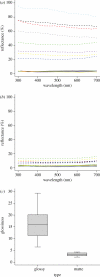What makes a feather shine? A nanostructural basis for glossy black colours in feathers
- PMID: 21123257
- PMCID: PMC3107640
- DOI: 10.1098/rspb.2010.1637
What makes a feather shine? A nanostructural basis for glossy black colours in feathers
Abstract
Colours in feathers are produced by pigments or by nanostructurally organized tissues that interact with light. One of the simplest nanostructures is a single layer of keratin overlying a linearly organized layer of melanosomes that create iridescent colours of feather barbules through thin-film interference. Recently, it has been hypothesized that glossy (i.e. high specular reflectance) black feathers may be evolutionarily intermediate between matte black and iridescent feathers, and thus have a smooth keratin layer that produces gloss, but not the layered organization of melanosomes needed for iridescence. However, the morphological bases of glossiness remain unknown. Here, we use a theoretical approach to generate predictions about morphological differences between matte and glossy feathers that we then empirically test. Thin-film models predicted that glossy spectra would result from a keratin layer 110-180 nm thick and a melanin layer greater than 115 nm thick. Transmission electron microscopy data show that nanostructure of glossy barbules falls well within that range, but that of matte barbules does not. Further, glossy barbules had a thinner and more regular keratin cortex, as well as a more continuous underlying melanin layer, than matte barbules. Thus, their quasi-ordered nanostructures are morphologically intermediate between matte black and iridescent feathers, and perceived gloss may be a form of weakly chromatic iridescence.
Figures





Similar articles
-
Iridescent plumage in satin bowerbirds: structure, mechanisms and nanostructural predictors of individual variation in colour.J Exp Biol. 2006 Jan;209(Pt 2):380-90. doi: 10.1242/jeb.01988. J Exp Biol. 2006. PMID: 16391360
-
Nanostructural self-assembly of iridescent feather barbules through depletion attraction of melanosomes during keratinization.J R Soc Interface. 2012 Apr 7;9(69):734-43. doi: 10.1098/rsif.2011.0456. Epub 2011 Aug 24. J R Soc Interface. 2012. PMID: 21865251 Free PMC article.
-
Proximate bases of silver color in anhinga (Anhinga anhinga) feathers.J Morphol. 2011 Nov;272(11):1399-407. doi: 10.1002/jmor.10993. Epub 2011 Jul 13. J Morphol. 2011. PMID: 21755527
-
Cytochemical and molecular characteristics of the process of cornification during feather morphogenesis.Prog Histochem Cytochem. 2008;43(1):1-69. doi: 10.1016/j.proghi.2008.01.001. Epub 2008 Mar 14. Prog Histochem Cytochem. 2008. PMID: 18394491 Review.
-
The evolutionary origin and diversification of feathers.Q Rev Biol. 2002 Sep;77(3):261-95. doi: 10.1086/341993. Q Rev Biol. 2002. PMID: 12365352 Review.
Cited by
-
Measuring spatially- and directionally-varying light scattering from biological material.J Vis Exp. 2013 May 20;(75):e50254. doi: 10.3791/50254. J Vis Exp. 2013. PMID: 23712059 Free PMC article.
-
Melanin-based structural coloration of birds and its biomimetic applications.Appl Microsc. 2021 Oct 11;51(1):14. doi: 10.1186/s42649-021-00063-w. Appl Microsc. 2021. PMID: 34633588 Free PMC article. Review.
-
Plastic sexual ornaments: Assessing temperature effects on color metrics in a color-changing reptile.PLoS One. 2020 May 20;15(5):e0233221. doi: 10.1371/journal.pone.0233221. eCollection 2020. PLoS One. 2020. PMID: 32433700 Free PMC article.
-
Production of plumage ornaments among males and females of two closely related tropical passerine bird species.Ecol Evol. 2017 Apr 25;7(11):4024-4034. doi: 10.1002/ece3.3000. eCollection 2017 Jun. Ecol Evol. 2017. PMID: 28616197 Free PMC article.
-
Making region-specific integumentary organs in birds: evolution and modifications.Curr Opin Genet Dev. 2021 Aug;69:103-111. doi: 10.1016/j.gde.2021.02.012. Epub 2021 Mar 27. Curr Opin Genet Dev. 2021. PMID: 33780743 Free PMC article. Review.
References
-
- McGraw K. 2006. Mechanics of carotenoid-based coloration. In Bird coloration (eds Hill G., McGraw K.), pp. 177–242 Cambridge, MA: Harvard University Press
-
- McGraw K. 2006. Mechanics of melanin-based coloration. In Bird coloration (eds Hill G., McGraw K.), pp. 243–294 Cambridge, MA: Harvard University Press
-
- Prum R. 2006. Anatomy, physics and evolution of structural colors. In Bird coloration (eds Hill G., McGraw K.), pp. 295–353 Cambridge, MA: Harvard University Press
-
- Durrer H. 1986. The skin of birds: coloration. In Biology of the integument 2: vertebrates (eds Matoltsy A., Richards K.), pp. 239–247 Berlin, Germany: Springer
-
- Maia R., Caetano J. V. O., Bao S. N., Macedo R. H. 2009. Iridescent structural colour production in male blue-black grassquit feather barbules: the role of keratin and melanin. J. R. Soc. Interface 6, S203–S21110.1098/rsif.2008.0460.focus (doi:10.1098/rsif.2008.0460.focus) - DOI - DOI - PMC - PubMed
Publication types
MeSH terms
Substances
LinkOut - more resources
Full Text Sources

